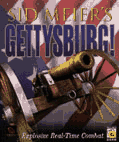The Classics are Born: 1990 to Present
Sid Meier’s Railroad Tycoon (1990)
Before real-time strategy became synonymous with fast-action-building Clone & Conquer games, it offered a deeper, more cerebral type of fun (still evident to a lesser degree in, say, Warcraft II). Sid Meier was taking a holiday in Europe, after finishing Gunship, to recharge his creative batteries, and he was musing over how much he had enjoyed Will Wright’s SimCity. Sid, however,
thought that for him to feel comfortable doing something similar, the end product would have to be more of a game and less of a "software toy" that had no real ending.
Sid’s life-long love of trains inspired him to come up with a real-time strategy game where would-be railroad tycoons could test their skills on multiple levels. Like Harpoon, you can speed up and slow down the pace of play in Sid Meier’s Railroad Tycoon to keep things hopping or to spend a little time micromanaging when necessary. Since you can pause the game at virtually any time, even hard-core turn-based gamers need feel no fear.
Basically, you start out with tiled topographical and natural resource maps of North America or Europe, not all that different from Civilization. After examining the possible routes and cargoes, you can build an infrastructure of rail lines, rolling stock, support services, and ancillary businesses to exploit the terrain where you are building your system. You don’t have to worry about antitrust laws – this is, after all, the Age of Robber Barons – and the only catch is that your network of interdependent businesses must be profitable, or the computer-played stockholders will lose interest.
The balance of building, investment, and railroad operations makes for an exciting game – hardly surprising, since codesigner Bruce Shelley was the genius behind Avalon Hill’s 1830 board game (later made into an interesting PC game in its own right). But what lures us back again and again to Railroad Tycoon are the AI opponents, representing such historical figures as Cornelius Vanderbilt; crafty and ruthless, they are still some of the toughest computer competition ever designed and almost enough to make up for the lack of multiplayer options.
Railroad Tycoon was a neat idea. It basically paved the way for Civilization, in that I got the idea of taking multiple simple systems and having them work together to create an interesting complexity. There was operating the railroad, playing the stock market, building track. It was like different things that individually are pretty simple and easy to understand and easy to get into, that when they interact, create an interesting kind of complexity.
We definitely played a lot of 1830 before we wrote Railroad Tycoon. I’d say we were halfway through the development, maybe two-thirds, before we added other railroads [to compete against]. We did a great deal of development just with the idea of you running the railroad more in a kind of SimCity sense; kind of like you’ve got something you’re building and nothing else is really going on. But we found halfway through that if we added other competing railroads, it would really give this kind of edge to the game that it didn’t have. Right now, you’re kind of taking your time building a railroad – that old track over here, running trains – which was fun; it was fun in the model railroading sense. But adding that little element of competition makes every decision a little more interesting.
So it was a long time before we added the idea of other railroads. You can kind of see in Railroad Tycoon, they’re implemented in a very haphazard fashion. They don’t follow the same rules as you do, and they’re verging on the afterthought, but I think they have their effect, which is to add another dimension to all your railroad decisions, and then they introduce the stock market and the competition, which is a fun part of the game. I’m not sure exactly where the idea of the personalities [of the computer opponents] came from, but it’s one that we’ve certainly used whenever, in Gettysburg and in other games. When you have an opponent, an AI, it’s always fun to give them different personalities, especially if you can attach a face and a name to them. It’s kind of one of those things that’s not too hard to do, and it adds a lot of value to the game.
Railroad Tycoon was also the first game I worked on with Bruce Shelley (Age of Empires). He was a great person to work with. What I found is that the good working relationships are with people that kind of fill in the holes – not two people that do the same thing and have the same skills, but two people that do complementary things. Bruce was a great guy to bounce off ideas. He had a lot of ideas. He was really interested in railroads and was very happy playing the game and giving me feedback and digging up facts and writing the manual. Really, all the things that I didn’t do very well, he did well. So we kind of made a powerful team in that sense.
Sid Meier’s Civilization (1991)

Design: Sid Meier with
Bruce Shelley
Publisher: MicroProse
Genre: Turn-Based Strategy/Wargame
Difficulty: Intermediate
If Sid Meier could ever meet with Alfred Hitchcock, they’d have a lot of stories to share. When you mention Hitchcock, most people immediately think of Psycho, or perhaps The Birds, as though those two thrillers could encapsulate the famed director’s style and technique over more than a half-century of films.
In much the same way, Sid Meier has become associated with Civilization and Civilization II, to the point where he’s been typecast as a "turn-based" game designer, despite his work in real-time sims and even action games. Civilization, like Will Wright’s SimCity, was one of the first "serious" computer games to break into the mainstream. Though I can only point to anecdotal evidence, I’d guess that more hours have been invested in conquering the worlds of Civilization than in any other computer game in the hobby’s history.
Civilization is not merely Sid Meier’s magnum opus, it’s also the quintessential world exploration/conquest game. Sid somehow manages to mix a lot of elements – economics, military actions, the nuts and bolts of government, long-range planning, and diplomacy – and combine them into a satisfying, addictive whole that captures the flow of human innovation and cultural expansion.
As your citizens become more literate and enjoy greater contact with other civilizations, for example, they demand a higher standard of living. How well you manage to build an economy while keeping your populace happy and productive on a city-by-city basis is a key to ultimate success in Civilization.
Meanwhile, you must travel the twin paths of global exploration and the unending search for knowledge, as you discover the wheel, learn to navigate the treacherous seas, and uncover the mysteries of flight. Along the way, you build Wonders of the World such as the Pyramids, Bach’s Cathedral, and the Great Library. Unlike games such as the recent Age of Empires, the Wonders in Civilization are not an end unto themselves, but provide economic, happiness, military, or other benefits to your civilization. And as one of the many nice touches in Civilization, most of the Wonders’ effects expire as the game goes on.
The secret to Civilization is that every time you think the game might possibly start to get dull, you discover some cool technology, you have to make another decision that significantly affects gameplay, and the cycle begins anew. Sid Meier has long been associated with gamelock – where you find yourself playing "just one more turn" for endless hours – but Civilization still holds up as many gamers’ worst gaming affliction ever, even after all these years.
SimCity inspired Civilization in a way. The first prototype of Civilization that I did was a real-time game like SimCity, in that you placed cities and moved things around, but cities grew without you. You basically seeded the world in a kind of SimCity-esque way. Instead of zoning, you seeded things, and you said I want a city over there, and why don’t you do some farming over here. What I didn’t like in that version of Civilization is that you did a lot more watching than you did playing. So SimCity, Empire, Railroad Tycoon, and the Civilization board game were the different ingredients that we stirred together to get to Civilization.
Civilization was a fantastic experience. Some games are a struggle to get together, and once we turned the corner and got away from the real-time SimCity-style game and made it turn-based, it really came together. It was fun from the beginning, and it just got more and more fun. I think in hindsight, it really drew on probably more of me than any other game. I played a lot of board games when I was a kid; I’d read a lot of history – I just found out I could put more and more stuff in that game. It was a big vessel that could hold the Romans, and it could hold riflemen, and it could hold airplanes, but the problem was I didn’t know where to stop. It was great that all the stuff I thought was cool when I was a kid – in going back in history to World War II and the Roman Empire and then Napoleon and the Civil War – could be put it in this game. The original game actually went further into the future. It had paratroopers and aegis cruisers, but the problem was there was never a good stopping point. You could always invent some new technology, and I finally said all right, we’re going to cut it off at World War II.
The original game was twice as big. Another rule I call the "Civilization Rule": Don’t make the map too big. The concept of Civilization was the history of the world, so you have to have a big map. The original map was twice the size, and the game just bogged down. Part of the pacing of a game is this relentless progress. We finally turned it around to where the map was smaller, time progressed more quickly, and the game felt epic, even though it moved pretty quickly. So that was another rule: More is not necessarily better.
Sid Meier’s Covert Action (1991)
One of the most neglected subgenres in all of gaming is that of espionage. Now that technology has progressed to allow similar "special effects" to those found in movies, we can enjoy action thrillers like GoldenEye and fulfill our James Bond fantasies – at least on console platforms (and eventually on PCs, if we’re lucky).
In the early ’90s, however, there was little available, other than insipid arcade rehashes of car chases and the occasional badly drawn polygonal spy lamely looking for clues in tired old adventure game style. Sid Meier thought he could change all that and bring the fun and mystery of techno-spies to the PC, much as he did in Pirates!
Unlike most of Sid’s games, however, the initial great idea didn’t pan out into classic, addictive gameplay. Sid Meier’s Covert Action couldn’t decide whether it wanted to be Mata Hari or James Bond:
The sleuthing was interesting, and at times the action was good, but the dichotomy between the two styles meant that you often forgot where you were in the game. This was a problem Sid would later have with his Civil War game, which he solved by limiting the focus to a single battle.
There were other problems, most notably the use of rubber bullets by your spies. Whatever happened to "license to kill?" The villains weren’t particularly memorable, either. Still, there are enough good ideas in Covert Action that it would be nice to see Sid take another crack at it – especially since the game’s most intriguing question has yet to be answered: Was supersleuth Max Remington the dapper male or the sexy female on the box’s cover?
Covert Action – also probably not on my top ten list. I actually stopped it. I started Covert Action and stopped it to do Railroad Tycoon. I started it up again, and, if I’m not mistaken, I stopped it to do Civilization.
The enduring memory I have from Covert Action is what I call the "Covert Action Rule," which is: It’s better to have one good game than two great games. The mistake I think I made in Covert Action is actually having two games in there kind of competing with each other. There was kind of an action game where you break into a building and do all sorts of picking up clues and things like that, and then there was the story which involved a plot where you had to figure out who the mastermind was and the different roles and what cities they were in, and it was a kind of an involved mystery-type plot.
I think, individually, those each could have been good games. Together, they fought with each other. You would have this mystery that you were trying to solve, then you would be facing this action sequence, and you’d do this cool action thing, and you’d get on the building, and you’d say, "What was the mystery I was trying to solve?" Covert Action integrated a story and action poorly, because the action was actually too intense. In Pirates!, you would do a sword fight or a ship battle, and a minute or two later, you were kind of back on your way. In Covert Action, you’d spend ten minutes or so of real time in a mission, and by the time you got out of [the mission], you had no idea of what was going on in the world.
So I call it the Covert Action Rule. Don’t try to do too many games in one package. And that’s actually done me a lot of good. You can look at the games I’ve done since Civilization, and there’s always opportunities to throw in more stuff. When two units get together in Civilization and have a battle, why don’t we drop out to a wargame and spend ten minutes or so in duking out this battle? Well, the Covert Action Rule. Focus on what the game is.
CPU Bach (1993)
Have you ever wanted your own music composer, one that only lived to create new tunes for you? Well, Sid Meier did, too. And possessing skills that mere mortals lack, he set out to create one.
CPU Bach is not a game by any means, nor is it just a software toy.
Publisher: MicroProse
Genre: Edutainment
Difficulty: Easy
It is one of the most sophisticated pieces of pure artificial intelligence ever created, both technically and conceptually. What CPU Bach does is to compose pieces of Bach-style music, based on the parameters that you set. The music can be as detailed as the Brandenburg Concertos, or simple, clean, and sparse, depending on how many virtual instruments you choose to use. It’s almost like having the ghost of Bach sitting in your living room, furtively cranking out all of the music he was unable to finish in his lifetime.
There are many reasons why Sid’s brainchild didn’t get the accolades that it deserved. The first is philosophical: No matter how much we enjoy being seduced by the rapid march of technology, we still feel uncomfortable when machines encroach on our preconceived notions of what constitutes art. Having a computer program crafting quality pieces of music is as upsetting to most people as a computer defeating Garry Kasparov in a chess match (though the latter admittedly had a bit more press).
Philosophical concerns aside, the main reason that CPU Bach never penetrated into the mainstream is that it was only available on the 3DO, a promising platform in 1993, but now clearly defunct. Why the 3DO? Sid, a passionate music lover and occasional composer, was uncomfortable with the PC sound standard, which by this time had defaulted to the lowest common denominator Sound Blaster. Sid wasn’t willing to put in the time on the project with the probability that most people would hear the music in 8-bit mono. The Macintosh entertainment market was still miniscule (remember, this was in the pre-Myst era), and the Amiga was already beginning its death throes, so that left only the 3DO (which MicroProse looked to as a new potential source of revenue in any case).
With Sid now at Firaxis, it’s unlikely that MicroProse (or anyone else) will ever do a PC version of CPU Bach with 3D sound, or even 16-bit stereo, which is a real shame, because this is potentially one of the great programs to hook the mainstream into computers: Just imagine what would happen if Sid did a CPU Duke Ellington….
I like Bach’s music; I enjoy Bach’s music. Bach had a bunch of sons, and one of them was not as responsible as the others, and he lost about a third of Bach’s music. That’s always been an incredible frustration (for me). If only someone could find this music, or if we only had the 7th Brandenburg Concerto, or we had more music from Bach…. So my motivation was to find a way to get more Bach music.
The other thing was really a response to Civilization. Civilization had been so successful, it had created this big wave of pressure of "what’s Sid going to do next?" I really sensed a danger that I didn’t want to get into this "topping myself every time" phenomenon. I saw mental illness down that road. I said I am not going to get in the business of topping Civilization and then trying to top what comes after Civilization. There lies madness.
This was something I had kind of wanted to play with for a while. Nobody’s going to compare it to Civilization and say, well, it’s a little more fun or it should have done this or whatever. So it was kind of a mental relaxation thing doing CPU Bach. It was a great, fun experience – definitely off the beaten track. Somewhat of an indulgence on my part, but it kind of got my brain back in shape again.
Sid Meier’s Colonization (1994)
 Design: Brian Reynolds
Design: Brian Reynoldsand Jeff Briggs with Sid
Meier
Publisher: MicroProse
Genre: Strategy/
Wargame
Difficulty: Intermediate
If the failure of the French at Waterloo can be seen as a day when "Napoleon was not being Napoleon," Colonization can likewise be remembered as the "Sid Meier game that wasn’t." By all accounts, Sid’s main contributions to the project came in the early concept stage and included some polishing just prior to the game being shipped. Most of the design work was done by the relatively unknown Brian Reynolds (who would later achieve fame for his work on Sid Meier’s Civilization II) and Jeff Briggs. Most computer gamers know Briggs as a fine composer of game soundtracks (notably Pirates! and Civilization II), but Jeff also had extensive design and development experience from his days at West End Games (board games and paper role-playing games).
The idea was sound: to produce a Sid Meier’s Civilization-style game on the early days of America, leading up to the American Revolution. As with Civilization, the game’s mechanics (combat, movement, exploration, and so forth) are in and of themselves fairly simple, so that Colonization is never quite overwhelming. Unlike Sid’s best games, however, you reach a point where you are waiting for something to happen; you don’t get that rush of new technology, so crucial in Civilization, to keep you riveted for another turn in Colonization.
The game isn’t a wash by any means. There are a lot of nice touches, such as building your cabinet, where you can choose Benjamin Franklin, Thomas Jefferson, and even Pocahontas as advisors. Colonization is also the first game where Reynolds introduced the concept of editable text files: If you don’t like a game rule or a victory condition, you can simply change it, without any programming skill required!
Colonization (still widely available in bargain bins) is interesting in a historical sense, mainly for collectors who want to see Brian Reynolds’ early development before he emerged as a top-flight game designer. Still, you can’t help but feel that Sid Meier’s Colonization could only have been helped by Sid’s active participation throughout the project, rather than his good name being tapped for marketing considerations, just because Sid sells games. With Sid, Brian, and Jeff gone to Firaxis, it’s doubtful that we’ll see a Colonization II, and that’s fine by me.
Colonization was designed primarily by Brian Reynolds, but it has a fair amount of my input as far as playing it and suggesting things. It was based, in some philosophical way, on Civilization, although it added a lot of new things.
I thought it was really impressive the way Brian stepped into this genre. He had done some graphic adventures before that, and he had just enjoyed playing Civilization and brought his own ideas. I think that was really impressive the way Brian stepped up to the plate and put the whole game together.
One thing that stands out in my mind is that two weeks before we shipped it, we made a major change in the gameplay. The original version had the city radius being twice the size that it was in the final game. We found that for gameplay purposes, all the cities tended to get kind of maxed out. And two weeks before we shipped it, we said, "You know, this game would be really more interesting if your cities specialize. So let’s cut the city radius, really change the nature of the gameplay."
The lesson I learned is that it’s never too late to fix the game, to fundamentally change the gameplay, because it can happen, even if you’re two weeks away from shipping. Keep making it better; keep fixing it.
Sid Meier’s CivNet (1995)
 Design: Sid Meier and
Design: Sid Meier andMike Denman
Publisher: MicroProse
Genre: Strategy
Difficulty: Intermediate
There are more varied opinions among gamers concerning CivNet than any other Sid Meier game. Some reveled in the chance to finally enjoy their favorite strategy game multiplayer, while others considered CivNet an abomination – most likely because, in all-too-typical mid-’90s MicroProse fashion, it took three patches before the bugs were sufficiently squashed to properly play the game.
Worse, MicroProse tried to pull the wool over the eyes of the fans of its most storied franchise by releasing CivNet a mere four months before Sid Meier’s Civilization II, without letting anyone know of the latter game’s impending release until after the sales curve of CivNet had flattened. The controversy deepened when Civilization II shipped with no multiplayer options, but with some evidence of multiplayer hooks buried in the code.
Even if you ignore all the controversy, CivNet is a mixed bag. It’s still Sid Meier’s Civilization at the core, but Civilization was really outdated graphically by 1995 (Operation Crusader and Panzer General led the way to SVGA graphics for strategy games in 1994, a year earlier). The Macintosh-like interface didn’t endear itself to PC strategists much, either. At one time, MicroProse was so out of touch with its audience that it actually considered making CivNet real time, but Sid himself evidently stepped in and squelched that idea.
With none of the scenarios or accelerated start options found just months later in Sid Meier’s Civilization II, it took an eternity to play a game of CivNet to a reasonable conclusion. And whatever small steps CivNet took towards simultaneous turn-based play, it has been surpassed by such games as Warlords III. The irony is that it’s taken MicroProse nearly three years to come up with what it should have done in the first place: a multiplayer version of Civilization II. If MicroProse takes the time to finish Ultimate Civ II Multiplayer, then CivNet can slip quietly into the dustbins of history.
Sid Meier’s Civilization II (1997)
 Design: Brian Reynolds
Design: Brian Reynoldsand Sid Meier
Publisher: MicroProse
Genre: Turn-Based
Strategy/Wargame
Difficulty: Intermediate
The true sequel to Sid Meier’s Civilization is marred only by its lack of multiplayer options (which will evidently be addressed this summer by MicroProse’s upcoming Ultimate Civilization II). Everything wonderful in the original Civilization is here – only more so. The expanded diplomacy options are nowhere near as involved as those in, say, Master of Orion II, but they add a lot to the richness of play with hardly any additional complexity. Likewise, the new subsystem for advanced trading of commodities becomes almost a game in itself; this is exactly what Avalon Hill’s Advanced Civilization wanted to do, but was unable to implement.
The new Wonders of the World – Leonardo’s Workshop, Marco Polo’s Embassy, et al. – help to round out the balance of military and political strategies in this incredibly deep game. The combat system has been overhauled, and in general, this classic game has been slightly streamlined and yet made more challenging at the same time. Even the multimedia enhancements – a brilliant soundtrack, well-produced video clips for Wonders, audiovisual advisors – help to ease the new and veteran player alike into the atmosphere.
The irony is that Brian Reynolds (who came up with most of the new design elements while working on his own from Europe) has been a good game designer for years, but most gamers think that his career began with Civilization II. Brian has said that he’s so proud of the game that he doesn’t mind. So, while you’re anxiously waiting for the upcoming Sid Meier’s Alpha Centauri – the next collaboration between Sid and Brian – consider turning a friend on to Civilization II, arguably the greatest game ever designed.
Civilization had been successful. It had never, even initially, been a technological marvel. The feeling was that we could do a significantly better job with presentation. We also had gotten so much play out of Civ. People had come up with new ideas. We had come up with ideas. So between better graphics and adding some of these gameplay things that people had come up with and we had come up with, there was really a need for a new game.
So Brian (Reynolds) had really sunk his teeth into that style of game. He essentially went to England for a year and put [Civ II] together. We would correspond and play variants and give him our feedback and ideas, ship him art every now and then, but it was amazing. He just did it on his own.
I think that the look of Civ II is certainly an improvement. My skin is thick, and people can tell me, "Sid, it looks like an EGA game" as much as they want – I accept that criticism. But we tackled that with Civ II. A lot of the new gameplay things polished and built on some of the ideas that we didn’t have a chance to follow through on in Civ. I think the diplomacy system in the original Civ was a little weak and the economic system – caravans and things – was cool, but I know that we added those towards the end. We didn’t totally exhaust what we could’ve done with them. Those systems were flushed out a little bit. Most of the games I’ve done have been somewhat new stuff, so what you’re getting is some new ideas, but not all of them are totally polished or finished. Civ II was a chance to go back to Civ and polish and finish up a lot of things.
Magic: The Gathering (1997)
Few games have captured the attention of the mainstream more than the Magic: The Gathering collectible card game. Magic is to the ’90s what Dungeons & Dragons was to the ’70s and Trivial Pursuit was to the ’80s. In short, Magic seemed an obvious choice for a computer conversion, and MicroProse snared the coveted contract.
Unlike the early D&D computer games, however, the development of Magic for the PC was so troubled that it would make for lively daytime drama. More than a year into the game’s development, no one could agree on the high concept. Arnold Hendrick, who had codesigned some of Sid’s finest games (Pirates! among them), wanted to emphasize multiplayer play – which, if you’ve ever been at GenCon and seen as many as 400 games of Magic going simultaneously in the open gaming area, seems in retrospect to be the right approach.
Sid was worried that an emphasis on multiplay would result in a poor AI. While this was a reasonable position to take, it might have had more to do with the fact that at this time Sid still wasn’t sold on multiplayer games (he hadn’t yet fallen in love with Warcraft II).
So, Magic took a different path from Arnold’s original concept, because whatever Sid wanted at this point in his MicroProse career, he basically got. The computer game added an adventure game shell – which got MicroProse into trouble with Acclaim, who had the adventure game rights to Magic – but this was less than enticing to veteran Magic players. Worse, the game’s AI suffered curious lapses, and thus, like most MicroProse products lately, it required a patch.
The final indignity is that there was no multiplayer option in Magic – the quintessential multiplayer collectible card game – until Manalink came out a year after the game’s initial release. To this day, Gilman Louie (head of MicroProse) insists that Sid Meier saved this product – and it is a decent game, although it is a bit strange that Sid’s career at MicroProse would end with such a dull thud rather than going out with, say, Civilization II.
You have to believe that if Sid got a second crack at Magic, he would design it as multiplayer from the ground up (for proof, look at the elegant multiplay in 1997’s Gettysburg) and would also add the AI for which Sid’s games are rightly famous.
Sid Meier’s Gettysburg (1997)
 Design: Sid Meier with Brian Reynolds
Design: Sid Meier with Brian ReynoldsPublisher: Firaxis/EA
Genre: Real-Time Wargame
Difficulty: Easy
Sid had always wanted to do a game on the American Civil War and had originally planned to do a turn-based strategic game with individual battles played out in real time. Problem was, you’d get so involved in the battles that you’d forget where you were in the overall picture. So, years later, when Sid moved to Firaxis, he decided to focus in detail on the most famous of all Civil War battles – Gettysburg.
Now, Sid’s view of 19th-century combat might not be as painstakingly accurate as TalonSoft’s Battleground games, but it delivers a potent Civil War punch. In Gettysburg, you really do feel as if you’re in the shoes of Robert E. Lee or George Meade because you are faced with the same challenges. Unlike most real-time games, for example, you can’t simply erect a base and start cranking out thousands of Rebels from Devil’s Den. Once your precious troops are gone, they’re gone, which puts events such as Pickett’s fateful charge into perspective.
Everything contributes to the period flavor, from the strains of martial music to the panoramic sweep of the formations, as they move toward famous objectives such as Little Round Top. You even find yourself listening for trumpet calls to give a clue concerning enemy maneuvers. The tutorials are among the best you’ll find in any genre, and the random maps and multiplayer options ensure that this is one game that really will play until Johnny comes marching home. The AI (always a Sid strength) can perform complex maneuvers – such as attacking enemy flanks – in ways that are beyond the capabilities of other real-time strategy games. Gettysburg was Sid’s first C++ coded game, and it also sported improved graphics compared with other Sid designs. Suffice it to say that Gettysburg is proof that the old master can still teach the industry new tricks.
I’m really happy with the Gettysburg game. I used to look at Civil War pictures when I was a kid, dreaming about this game and wanting a game to look like this and play like that. From that point of view, the game really turned out the way that I wanted it to. I see the images, and what’s happening on the screen is what I want to happen on the screen.
I’m not even sure how it happened, but the AI works. And that is neat these days, because a lot of games are tending to put one big effort in the multiplayer camp and slight the single-player play. I don’t think it’s quite time to do that yet. So I’m glad there’s a strong single-player game in Gettysburg, even though this is really the first multiplayer game that I’ve programmed. And the multiplayer is a great deal of fun. My eyes were opened to a great extent by how much fun the multiplayer stuff is and how much that added to the game.
I think it captures what I think of as the Civil War. I’ve played a lot of Civil War games, but this is, in my imagination, what the Civil War is like. The cool part of the Civil War is the battlefield, the excitement, the action, the surprise seeing those guys coming out of the woods and seeing if I have time to get in a formal [formation] line. It’s neat to know that you’re actually playing the game five minutes ahead most of the time, that you’re actually projecting where you are going to be, where they are going to be a couple minutes from now, and responding to that vision as opposed to what’s actually happening on the screen. Which is so different from all the real-time games. When I play most real-time games, I’m ten seconds behind. I’m trying to grab all these guys and go over that way…. It’s like I’m always behind the eight ball, because I’ve got to do ten more clicks just to carry out what I wanted to do, not to mention what I’m going to do next.
In Gettysburg, I think I’m playing ahead – I’m anticipating. I have this feeling that I’m in control. So it’s a whole thing that’s happening in my mind as opposed to most of the clicking games where I’m just trying to keep up with what’s going on, on the screen. That may be my personal feeling, but I like Gettysburg because it’s kind of where I would like to see real-time games go in a certain sense, too. A little more depth, a little less clicking, a little more having this whole thing playing out in your mind.
Sid on the State of the Game Industry
"I kind of miss the days when games were judged on their game-playing merit alone. I’m a little concerned about how far we (the game industry) are into the licensed four-page-ad marketing blitz era these days, which may be a natural evolution of the industry. But I’m always worried when we put more emphasis on glitz and production values than on the game. That’s a trend that looks good for a while until you realize there’s no game industry any more. If we don’t have gameplay, we can’t really compete with other forms of entertainment because we can’t do graphics as good as the movie industry and we can’t make sounds as well as the recording industry. All we can do that’s special to us is be interactive. So we have to hang on to that and make sure we do a good job.
"There’s a key difference between games and movies. In a game, the more attention that’s focused on the player, the more successful it is. In a movie, you’re really watching somebody else’s story, so the better the story or the better the actor, the more interested you are in the movie. In a game, the more interesting you are as a player, the more successful the game is. So, in a way, things that work in movies are designed to impress you with what somebody else is doing. A good game impresses you with what you’re doing. I think that’s a fundamental difference that I as a game designer need to recede in the background. The more the player is thinking about the design or the designer, the less successful I’ve been, because I want the player to forget somebody designed this game, forget that this is a game, and believe that this is an experience that the player is having. Whereas in a movie, the more you’re aware of the director or the stars, the more you’re impressed with them – that helps the movie to be successful. In a way, trying to impress people with design or personality or whatever works to promote movies doesn’t work with games because it takes the focus off the player who is supposed to be the star. The more the player is the star, the better a game you have.
"There are certain similarities in terms of subject matter, marketing, getting people excited about experiences, and things like that, but I think the idea of the focus on the player is something we have that is very different from other forms of entertainment."
Related Links
Check out more about Sid Meier’s games here on GameSpot. Just click on the links below.
Sid Meier’s Gettysburg! GameSpot Review
GameSpot reviewer Michael E. Ryan says, "Gettysburg! may be the first release from newcomer Firaxis Games, but it has all the polish and appeal of a Meier classic."
Sid Meier’s Civilization II GameSpot Review
Check out Trent Ward’s review of the sequel to this Sid Meier classic.
Civ II: Fantastic Worlds GameSpot Review
Get more game from Civilization II with this add-on, but read the GameSpot review before you buy.
The Ultima Legacy
GameSpot reveals the long history and promising future of Ultima, one of the longest running computer game series of all time. Includes behind-the-scenes commentary by creator Richard Garriott, a.k.a. Lord British, himself



